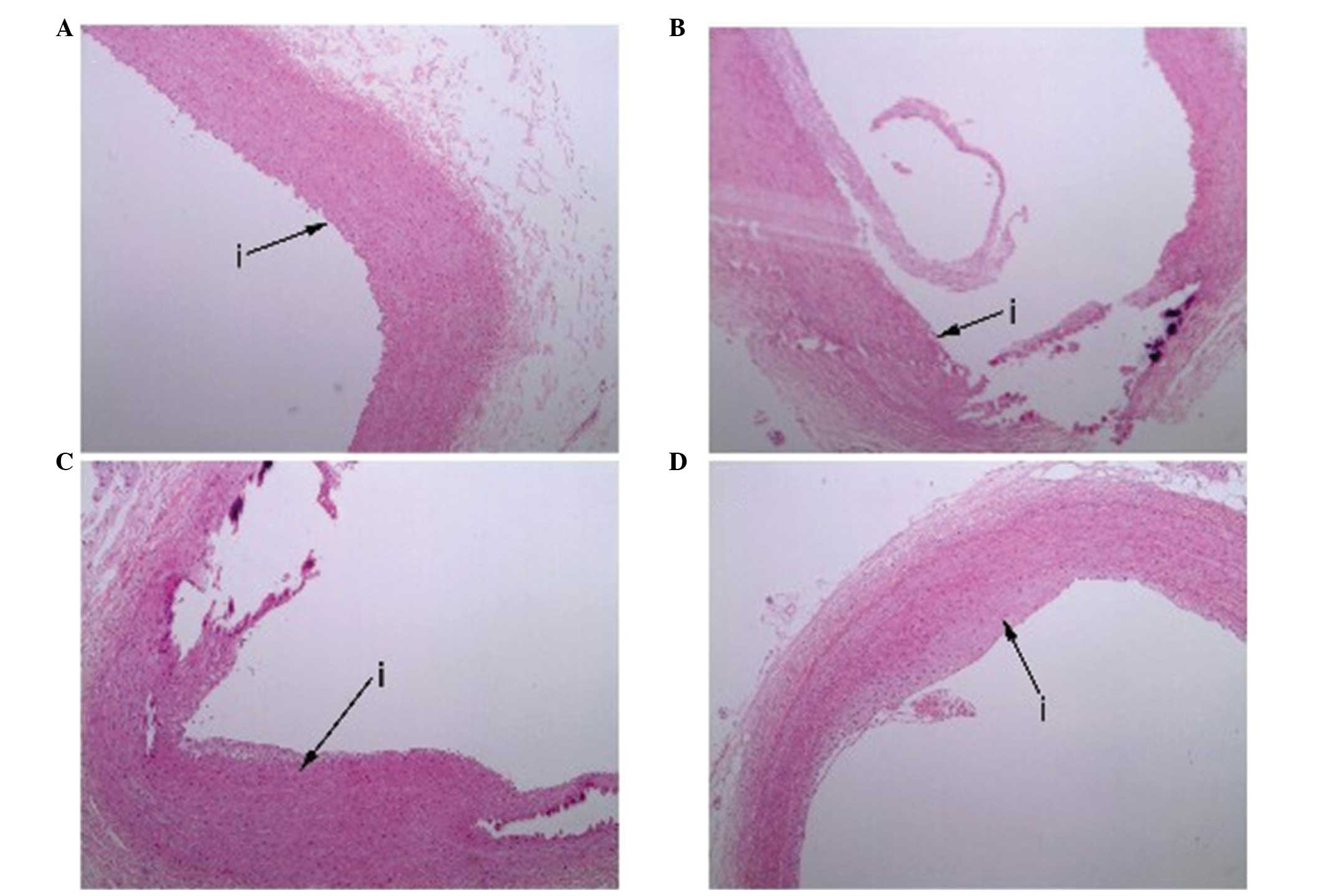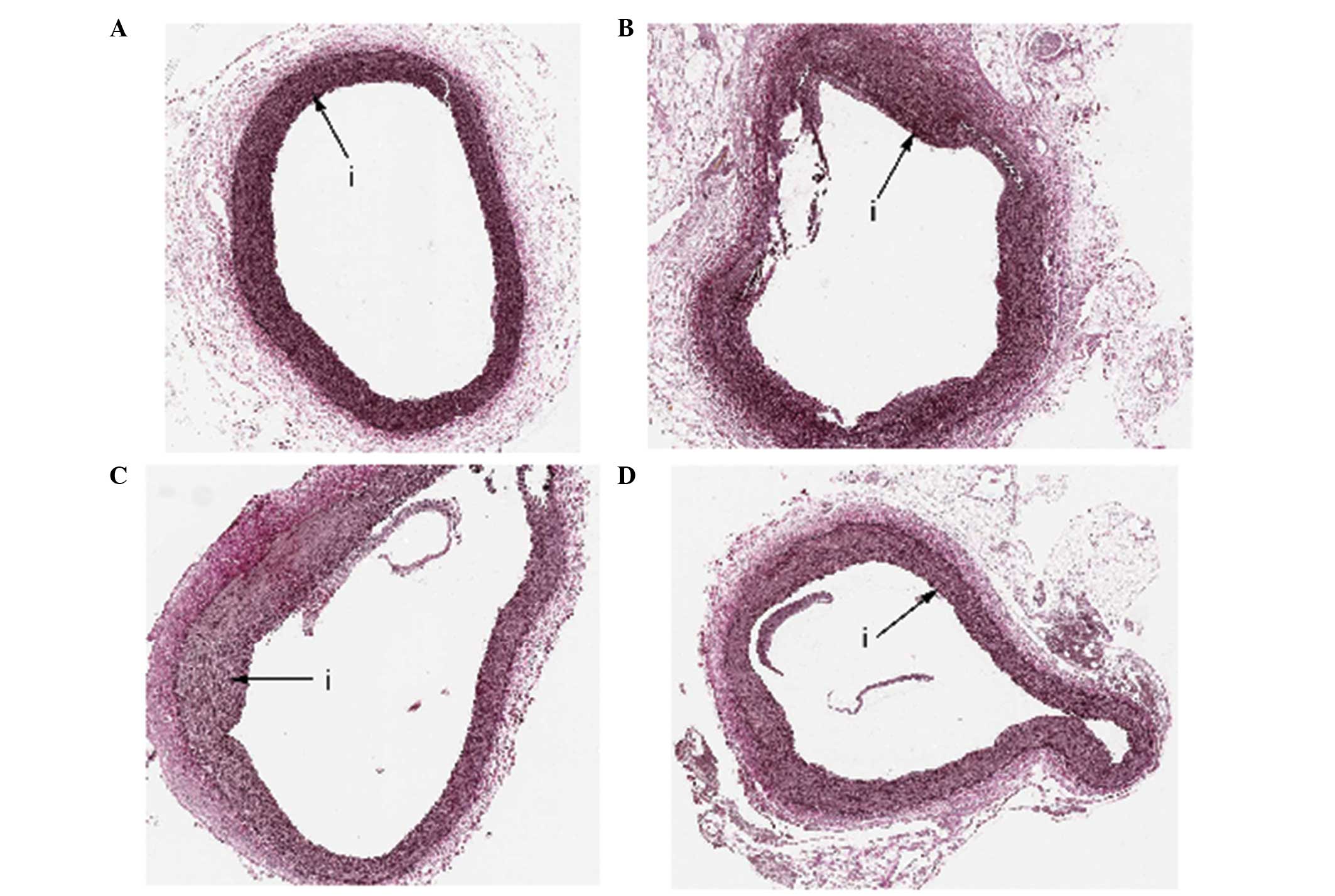|
1
|
Singh M, Rihal CS, Berger PB, et al:
Improving outcome over time of percutaneous coronary interventions
in unstable angina. J Am Coll Cardiol. 36:674–678. 2000. View Article : Google Scholar : PubMed/NCBI
|
|
2
|
Kim MS and Dean LS: In-stent restenosis.
Cardiovasc Ther. 29:190–198. 2011. View Article : Google Scholar : PubMed/NCBI
|
|
3
|
Jukema JW, Verschuren JJ, Ahmed TA and
Quax PH: Restenosis after PCI. Part 1: pathophysiology and risk
factors. Nat Rev Cardiol. 9:53–62. 2011. View Article : Google Scholar : PubMed/NCBI
|
|
4
|
Qiu Y, Hoareau-Aveilla C, Oltean S, Harper
SJ and Bates DO: The anti-angiogenic isoforms of VEGF in health and
disease. Biochem Soc Trans. 37:1207–1213. 2009. View Article : Google Scholar : PubMed/NCBI
|
|
5
|
Ferrara N: The role of VEGF in the
regulation of physiological and pathological angiogenesis. EXS.
94:209–231. 2005.PubMed/NCBI
|
|
6
|
Hiltunen MO, Laitinen M, Turunen MP, et
al: Intravascular adenovirus-mediated VEGF-C gene transfer reduces
neointima formation in balloon-denuded rabbit aorta. Circulation.
102:2262–2268. 2000. View Article : Google Scholar : PubMed/NCBI
|
|
7
|
Dulak J, Schwarzacher SP, Zwick RH, et al:
Effects of local gene transfer of VEGF on neointima formation after
balloon injury in hypercholesterolemic rabbits. Vasc Med.
10:285–291. 2005. View Article : Google Scholar : PubMed/NCBI
|
|
8
|
Simón-Yarza T, Formiga FR, Tamayo E, et
al: Vascular endothelial growth factor-delivery systems for cardiac
repair: an overview. Theranostics. 2:541–552. 2012. View Article : Google Scholar : PubMed/NCBI
|
|
9
|
Asahara T, Bauters C, Pastore C, et al:
Local delivery of vascular endothelial growth factor accelerates
reendothelialization and attenuates intimal hyperplasia in
balloon-injured rat carotid artery. Circulation. 91:2793–2801.
1995. View Article : Google Scholar : PubMed/NCBI
|
|
10
|
Gaffney MM, Hynes SO, Barry F and O'Brien
T: Cardiovascular gene therapy: current status and therapeutic
potential. Br J Pharmacol. 152:175–188. 2007. View Article : Google Scholar : PubMed/NCBI
|
|
11
|
Rutanen J, Turunen AM, et al: Gene
transfer using the mature form of VEGF-D reduces neointimal
thickening through nitric oxide-dependent mechanism. Gene Ther.
12:980–987. 2005. View Article : Google Scholar : PubMed/NCBI
|
|
12
|
Deiner C, Schwimmbeck PL, Koehler IS, et
al: Adventitial VEGF165 gene transfer prevents lumen loss through
induction of positive arterial remodeling after PTCA in porcine
coronary arteries. Atherosclerosis. 189:123–132. 2006. View Article : Google Scholar : PubMed/NCBI
|
|
13
|
Pels K, Deiner C, Coupland SE, et al:
Effect of adventitial VEGF(165) gene transfer on vascular
thickening after coronary artery balloon injury. Cardiovasc Res.
60:664–672. 2003. View Article : Google Scholar : PubMed/NCBI
|
|
14
|
Hutter R, Carrick FE, Valdiviezo C, et al:
Vascular endothelial growth factor regulates reendothelialization
and neointima formation in a mouse model of arterial injury.
Circulation. 110:2430–2435. 2004. View Article : Google Scholar : PubMed/NCBI
|
|
15
|
Liu Q, Lu Z, Yue Y, et al: Experimental
study of adenovirus vector mediated-hVEGF165 gene on prevention of
restenosis after angioplasty. J Huazhong Univ Sci Technolog Med
Sci. 24:132–133, 137. 2004. View Article : Google Scholar : PubMed/NCBI
|
|
16
|
Walter DH, Cejna M, Diaz-Sandoval L, et
al: Local gene transfer of phVEGF-2 plasmid by gene-eluting stents:
an alternative strategy for inhibition of restenosis. Circulation.
110:36–45. 2004. View Article : Google Scholar : PubMed/NCBI
|
|
17
|
Hedman M, Hartikainen J, Syvänne M, et al:
Safety and feasibility of catheter-based local intracoronary
vascular endothelial growth factor gene transfer in the prevention
of postangioplasty and in-stent restenosis and in the treatment of
chronic myocardial ischemia: phase II results of the Kuopio
Angiogenesis Trial (KAT). Circulation. 107:2677–2683. 2003.
View Article : Google Scholar : PubMed/NCBI
|
|
18
|
Hedman M, Muona K, Hedman A, et al:
Eight-year safety follow-up of coronary artery disease patients
after local intracoronary VEGF gene transfer. Gene Ther.
16:629–634. 2009. View Article : Google Scholar : PubMed/NCBI
|
|
19
|
Jin S and Ye K: Nanoparticle-mediated drug
delivery and gene therapy. Biotechnol Prog. 23:32–41. 2007.
View Article : Google Scholar : PubMed/NCBI
|
|
20
|
Zhang Y, Chirmule N, Gao GP, et al: Acute
cytokine response to systemic adenoviral vectors in mice is
mediated by dendritic cells and macrophages. Mol Ther. 3:697–707.
2001. View Article : Google Scholar : PubMed/NCBI
|
|
21
|
Brunetti-Pierri N, Palmer DJ, Beaudet AL,
et al: Acute toxicity after high-dose systemic injection of
helper-dependent adenoviral vectors into nonhuman primates. Hum
Gene Ther. 15:35–46. 2004. View Article : Google Scholar : PubMed/NCBI
|
|
22
|
Kircheis R, Wightman L and Wagner E:
Design and gene delivery activity of modified polyethylenimines.
Adv Drug Deliv Rev. 53:341–358. 2001. View Article : Google Scholar : PubMed/NCBI
|
|
23
|
Golub JS, Kim YT, Duvall CL, et al:
Sustained VEGF delivery via PLGA nanoparticles promotes vascular
growth. Am J Physiol Heart Circ Physiol. 298:H1959–H1965. 2010.
View Article : Google Scholar : PubMed/NCBI
|
|
24
|
Jain RA: The manufacturing techniques of
various drug loaded biodegradable poly(lactide-co-glycolide) (PLGA)
devices. Biomaterials. 21:2475–2490. 2000. View Article : Google Scholar : PubMed/NCBI
|
|
25
|
Panyam J and Labhasetwar V: Biodegradable
nanoparticles for drug and gene delivery to cells and tissue. Adv
Drug Deliv Rev. 55:329–347. 2003. View Article : Google Scholar : PubMed/NCBI
|
|
26
|
Brito L and Amiji M: Nanoparticulate
carriers for the treatment of coronary restenosis. Int J
Nanomedicine. 2:143–161. 2007.PubMed/NCBI
|
|
27
|
Guzman LA, Labhasetwar V, Song C, et al:
Local intraluminal infusion of biodegradable polymeric
nanoparticles. A novel approach for prolonged drug delivery after
balloon angioplasty. Circulation. 94:1441–1448. 1996. View Article : Google Scholar : PubMed/NCBI
|
|
28
|
Paul A, Shao W, Shum-Tim D and Prakash S:
The attenuation of restenosis following arterial gene transfer
using carbon nanotube coated stent incorporating TAT/DNA
(Ang1+Vegf) nanoparticles. Biomaterials. 33:7655–7664. 2012.
View Article : Google Scholar : PubMed/NCBI
|
|
29
|
Yang J, Zeng Y, Zhang C, et al: The
prevention of restenosis in vivo with a VEGF gene and paclitaxel
co-eluting stent. Biomaterials. 34:1635–1643. 2013. View Article : Google Scholar : PubMed/NCBI
|
|
30
|
World Medical Association: Guiding
principles for research involving animals and human beings. Am J
Physiol Heart Circ Physiol. 281:3 following. H27612001.
|
|
31
|
Xu YY, Li YJ, Guan H, et al: The effect of
vascular endothelia growth factor encapsulated in nanoparticles on
chronic limb ischemia. Zhonghua Wai Ke Za Zhi. 42:58–61.
2004.PubMed/NCBI
|
|
32
|
Sasaki M, Sawada N, Minase T, Satoh M and
Mori M: Collagen-gel-embedded three-dimensional culture of human
thyroid epithelial cells: comparison between the floating sandwich
method and the dispersed embedding method. Cell Struct Funct.
16:209–215. 1991. View Article : Google Scholar : PubMed/NCBI
|
|
33
|
Nagae T, Aizawa K, Uchimura N, et al:
Endovascular photodynamic therapy using mono-L-aspartyl-chlorin e6
to inhibit Intimal hyperplasia in balloon-injured rabbit arteries.
Lasers Surg Med. 28:381–388. 2001. View
Article : Google Scholar : PubMed/NCBI
|
|
34
|
Herdeg C, Göhring-Frischholz K, Haase KK,
et al: Catheter-based delivery of fluid paclitaxel for prevention
of restenosis in native coronary artery lesions after stent
implantation. Circ Cardiovasc Interv. 2:294–301. 2009. View Article : Google Scholar : PubMed/NCBI
|
|
35
|
Kettler K, Veltman K, van de Meent D, van
Wezel A and Hendriks AJ: Cellular uptake of nanoparticles as
determined by particle properties, experimental conditions, and
cell type. Environ Toxicol Chem. 33:481–492. 2014. View Article : Google Scholar : PubMed/NCBI
|
|
36
|
Westedt U, Barbu-Tudoran L, Schaper AK, et
al: Deposition of nanoparticles in the arterial vessel by porous
balloon catheters: localization by confocal laser scanning
microscopy and transmission electron microscopy. AAPS Pharm Sci.
4:E412002. View
Article : Google Scholar
|
|
37
|
Mäkinen K, Manninen H, et al: Increased
vascularity detected by digital subtraction angiography after VEGF
gene transfer to human lower limb artery: a randomized,
placebo-controlled, double-blinded phase II study. Mol Ther.
6:127–133. 2002. View Article : Google Scholar : PubMed/NCBI
|
|
38
|
Stewart DJ, Kutryk MJ, Fitchett D, Freeman
M, et al: VEGF gene therapy fails to improve perfusion of ischemic
myocardium in patients with advanced coronarydisease: results of
the NORTHERN trial. Mol Ther. 17:1109–1115. 2009. View Article : Google Scholar : PubMed/NCBI
|
|
39
|
Wirth T, Hedman M, et al: Safety profile
of plasmid/liposomes and virus vectors in clinical gene therapy.
Curr Drug Saf. 1:253–257. 2006. View Article : Google Scholar : PubMed/NCBI
|













